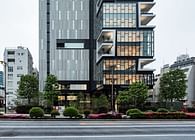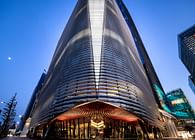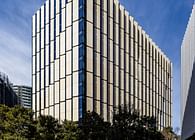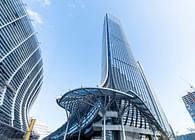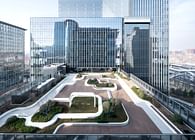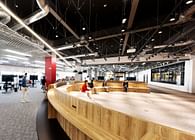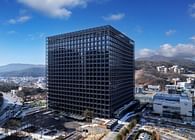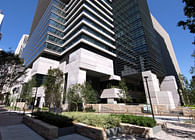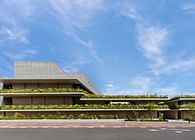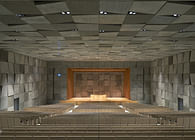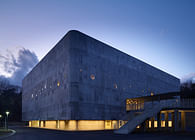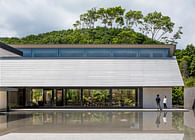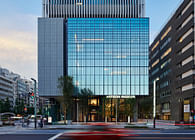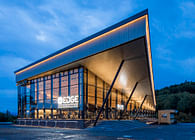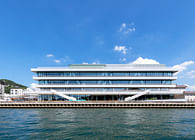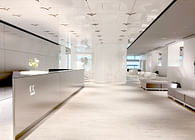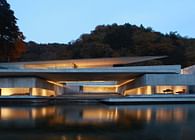
A “Spaceship” Floating in the Old City
The site is located approximately 10 km west of Chongqing’s city center in a suburban area known for its concentration of educational institutions such as universities. Shapingba Station, within the site, was once temporarily suspended due to a decline in users but has been restructured following the introduction of high-speed rail from Chengdu to Chongqing.
In addition to the high-speed rail, the site features multiple long-distance railways and three subway lines. A complex comprising a hotel, offices, commercial spaces and rest areas was constructed above the tracks. The consolidation of various urban functions has resulted in a new landmark with a floor area of 480,000 square meters in the old city. This model of joint development between a high-speed rail station and its surrounding area is the first of its kind in China and has been dubbed the “Shapingba Model” by the media.
Design Challenges
The project site measures approximately 600 meters in length and 200 meters in width, surrounded by busy roads on all four sides, with a high-speed railway running east-west through the middle. The combination of surrounding traffic conditions and Chongqing’s characteristic hilly terrain makes the site feel like an isolated island that is not easily walkable. Additionally, the high-speed railway station located in the center of the site divides it into eastern and western parts, further fragmenting the land. The main challenge is how to enhance the project’s cohesion in terms of both development and transportation connections.
Design Strategy 1: Connecting the City with a Pedestrian Network
The first step in the design was to establish a pedestrian network around the site. The surrounding area is divided by railway tracks, with commercial facilities to the north and residential areas to the south. To connect the two divided regions, parts of the railway and some roads were semi-undergrounded, and a new deck was created on the surface. The free passage on the deck connects to the existing road network around the site, forming a looped pedestrian pathway that links north and south. The Urban Core placed at the center of the main looped pathway, serves as a vertical circulation hub. Additionally, public spaces integrated with pedestrian pathways were arranged around the Urban Core, aiming to create a “fun, walkable city” where activities and events are encouraged.
Design Strategy 2: Achieving Efficient Transfers with Integrated Public Transportation and Urban Core
Before considering the attraction of customers, it is essential to ensure smooth traffic flow within the site. Considering high-speed rail, subways, and buses, the site is expected to accommodate approximately 400,000 users per day. Since subway passengers are the most numerous, the plan aims to strengthen connections between the subway, station building, buses, taxis, and surrounding areas.
First, Urban Cores were placed on both the east and west sides where all public transportation intersects. The Urban Core consists of two parts: the above-ground volume and the underground void. The above-ground part is principally a five-story structure for commercial development, while the underground part extends to eight levels below ground, housing transfer and development pathways. The above-ground section is characterized by pilotis spaces that penetrate the city blocks and are used as a free passage. The floating volume of the pilotis naturally draws the external landscape underground, enriching the transfer experience and creating a “sense of arrival.”
The Urban Core efficiently connects three subway lines on the seventh and eighth basement levels, the high-speed railway on the fourth basement level, the taxi stand on the second basement level, and the bus terminal on the first basement level. This arrangement facilitates easy transfers between different transportation functions. Additionally, the Urban Core, along with the free passage, forms a network that distributes the flow of people not only within the site but also to surrounding urban and development projects, transforming transportation into regional vitality.
Design Strategy 3: Creating a Landmark to Revitalize the Old City
The area where the site is located is an old urban district with outdated and cluttered surroundings. In addition to organizing traffic flow, creating a landmark image is also crucial.
Above the Urban Core, an elliptical volume resembling a spaceship, measuring 80 meters in length and 37 meters in width, has been designed. Its spiral shape evokes a futuristic image. Additionally, a two-story high screen installed at the top of the Urban Core faces the main axis of the northern shopping district, attracts the attention of the 300,000 visitors who pass through on average per day. Here, the transfer pathways and free passage intersect, and the lines of sight from the surrounding blocks converge. This “spaceship” acts as a catalyst to revitalize the old urban district.
Design Strategy 4: Forming the Skyline with Twin Towers—An Integrated Design for a 600m Long by 200m High Facade
The surrounding old buildings had varying heights, resulting in an uneven skyline. To create a group silhouette appropriate for Shapingba and to serve as a regional symbol, we redesigned the skyline with high-rise buildings centered around the twin towers.
In the facade design, emphasis was placed on Chongqing's characteristic “mountain city” features. The twin towers were envisioned to resemble the gorges of the Yangtze River, with facades that flow down like waterfalls, connecting to the commercial areas on both sides. The lower part of the towers integrates the station entrance and the commercial facade, creating a design that minimizes the perceived east-west division caused by the station. By leveraging the design feature of the site's excessive length, the twin towers integrated with the lower levels stand out from the previously cluttered skyline, creating a 600m long by 200m high urban landmark. The concept of integrated station-town development is reflected not only in functionality but also in the expression of the facade image.
Project Details
Project name: Chongqing Longfor Shapingba Station Golden Sand Paradise Walk Purpose: High-Speed Railway Station, Commercial Building, Hotel, Office Location (prefecture, city): Chongqing, China Site area (m2): 85,120m² Total floor area (m2): Approx. 480,000m² Number of floors: 41 floors above ground Eave height/maximum height (m): 200m Main structure: Reinforced Concrete Completion month/year: December 2020
Credits
Client name: Chongqing Longfor Jingnan Properties Co., Ltd.
Lead architect: Nikken Sekkei Ltd
Main scope: Master Architect, Initial Low-Rise Exterior, Construction Supervision JV, joint design, supervision, consulting, etc.: China Southwest Architectural Design and Research Institute Corp. Ltd Construction Contractor: China Construction Eighth Engineering Division Corp. Ltd. Other cooperating companies: Curtain Wall Consultant: Xumilin Energy Technology Co., Ltd. An'yan Design
Photo credit 1: Large Format Photography Studio
Photo credit 2: Chongqing Longfor Jingnan Properties Co., Ltd.
Status: Built
Location: Chongqing, CN
Firm Role: Lead architect: Master Architect, Initial Low-Rise Exterior, Construction Supervision
Additional Credits: JV, joint design, supervision, consulting, etc.: China Southwest Architectural Design and Research Institute Corp. Ltd Construction Contractor: China Construction Eighth Engineering Division Corp. Ltd. Other cooperating companies: Curtain Wall Consultant: Xumilin Energy Technology Co., Ltd. An'yan Design




